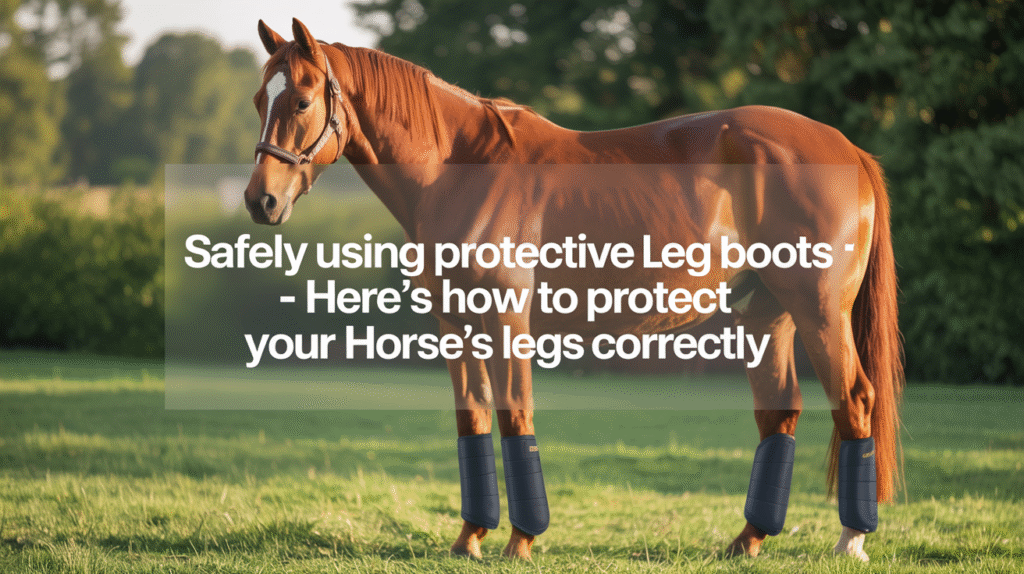The safest way to use protective leg boots is by choosing the right type for your horse’s activity, ensuring a snug but non-restrictive fit, and keeping the boots clean and well-maintained. Whether your horse is jumping, schooling, trail riding, or rehabilitating from injury, properly applied leg protection can prevent serious injuries, reduce strain, and enhance comfort during work.

Here’s a comprehensive guide on how to use protective leg boots effectively and safely.
Why Protective Leg Boots Are Important
Leg boots serve as a physical barrier between your horse’s legs and potential sources of injury.
Prevents Impact Injuries
Leg boots shield against accidental knocks and interference.
- Protects from brushing, forging, and overreaching injuries.
- Reduces risk during jumps, tight turns, or high-speed work.
Offers Support and Stability
Certain boots offer additional structure during work.
- Helps stabilize joints and tendons during movement.
- Reduces strain on ligaments, especially in intense disciplines.
Different Types of Leg Boots and Their Uses
The type of leg boot you need depends on your horse’s activity level, training discipline, and any special medical considerations.
Brushing Boots
These are among the most commonly used boots.
- Protect the inside of the legs from brushing injuries.
- Ideal for flatwork, schooling, and light jumping.
Tendon Boots
Often used in show jumping and eventing.
- Designed to protect the tendons from impact, especially from hind hooves.
- Usually worn on the front legs with a strike plate for added protection.
Fetlock Boots
Paired with tendon boots, these protect the hind legs.
- Cover the fetlock joint to guard against brushing or overreaching.
- Commonly used in show jumping.
Overreach Boots (Bell Boots)
Wrap around the pastern and cover the heel area.
- Prevent injuries from overreaching where the hind foot strikes the front heel.
- Useful for turnout, schooling, and jumping.
Sports Medicine Boots
Designed for overall leg support and protection.
- Provide light compression to aid circulation and reduce fatigue.
- Popular in Western disciplines, barrel racing, and trail riding.
Shipping Boots
Used during transportation.
- Long, padded boots that protect from hoof to knee or hock.
- Prevent bumps and scrapes while loading, unloading, or traveling.
How to Fit Protective Boots Properly
The correct fit ensures the boots protect effectively without causing discomfort or circulation problems.
Position Boots Correctly
Each boot should align with the leg’s contours.
- Start from the front and wrap toward the back (except overreach boots).
- Avoid leaving gaps or twisting the boots as you secure them.
Secure Snugly but Not Tightly
A too-tight boot can impair circulation; too loose can slip or rotate.
- You should be able to slide a finger under the strap comfortably.
- Ensure even pressure across all straps or fastenings.
Use Matching Pairs
Each boot is usually shaped specifically for the left or right leg.
- Check for labels or shapes indicating left/right orientation.
- Using the wrong boot on the wrong leg may reduce protection.
Maintenance and Care for Leg Boots
Proper care extends the life of the boots and protects your horse’s skin.
Clean After Every Ride
Dirt and sweat can cause rubbing, irritation, or infection.
- Rinse with water or wipe down with a damp cloth.
- Use mild soap if needed and ensure they dry thoroughly before reuse.
Inspect for Wear and Tear
Check for damage before every use.
- Look for broken straps, cracks, or worn padding.
- Replace boots that have lost their structure or protective ability.
Store in a Cool, Dry Place
Humidity or sunlight can degrade materials over time.
- Avoid storing in tack boxes with moisture.
- Use mesh bags for ventilation when boots are not in use.
When to Use and When to Avoid Boots
Boots are helpful, but not always necessary.
Use During High-Impact Activities
Certain routines require added protection.
- Jumping, eventing, galloping, or trail riding through rough terrain.
- Horses with a history of interference or leg injuries.
Avoid Overuse in Heat or Rest
Wearing boots unnecessarily can create problems.
- Can trap heat and increase the risk of overheating tendons.
- Remove immediately after work and avoid during rest periods.
FAQs
Here are some questions and answers about safely using protective leg boots:
How tight should leg boots be?
Leg boots should be snug but not tight. You should be able to slide one finger between the boot and the horse’s leg. Avoid restricting blood flow or causing pressure points.
Can I leave protective boots on all day?
No. Boots should only be worn during exercise, training, or transport. Prolonged wear can trap heat and moisture, leading to irritation or skin damage.
How do I know if my horse needs leg boots?
If your horse tends to knock legs together, is recovering from a leg injury, or does high-impact work, boots are a good preventive measure. A trainer or vet can help assess your horse’s specific needs.
Are front and hind boots interchangeable?
No. Tendon and fetlock boots are specifically designed for front and hind legs, respectively. Using them interchangeably can reduce effectiveness or cause discomfort.
Can boots cause problems if used incorrectly?
Yes. Boots that are too tight, too loose, or not cleaned properly can cause rubbing, sores, or even tendon strain due to trapped heat.
Safely using protective leg boots means choosing the right type for your horse’s needs, ensuring proper fit, and maintaining them with care. When used correctly, these boots can be a powerful tool for injury prevention and performance support, giving both rider and horse peace of mind during every ride.